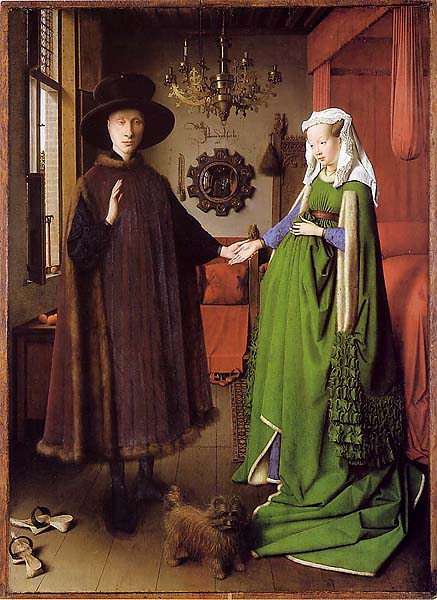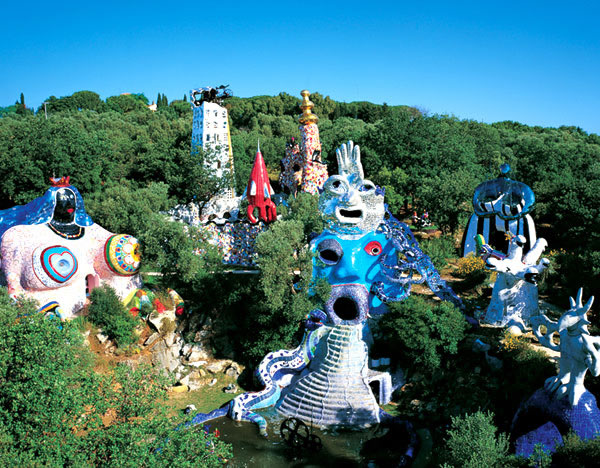Friday, March 13, 2009
The Daughters of Edward Darley Boit
Ok, I don't think that there is a ton of symbolism in this painting as it could easily be a simple portrait but-- there are a couple of things that I would like to mention about it. Most importantly, all of the girls look very much alike. So, they could be sisters OR it could be the depiction of the same girl in different stages of her life. It's interesting because as she gets older, she retreats more into the shadows until finally, at her oldest, she is no longer facing out. The youngest girl is innocence, curiosity. She is closest to us-- it's like she blindly trusts the audience or society in general. Also, she is dressed in all white-- a color of purity and childhood. As the girl(s) get older they are darker and farther away. I think that this painting in itself symbolizes what happens when a child ages and how their relationship with society changes with them.
The Ambassadors
In reading about this painting, I learned that some people think that there are three levels symbolizing heaven, earth, and death--- or hell I guess. I also learned that several of the objects on the shelves represent France and therefore the implication that the men in the portrait will remain loyal to their home while living abroad. The broken lute string represents something bad-- not too sure what. Something to do with current events maybe? The books can represent enlightenment in religion and learning, and the skull represents mortality.
Henry Ford Hospital
The woman (Frida) is lying on the bed after a miscarriage. The six objects surrounding her all symbolize something to do with said miscarriage. The orchid, I learned, was a gift from Diego. The pelvis is Frida's own misshapen pelvis from an early accident that prevents her from having children. The fetus is obviously the dead child. The slug is to show how long and drawn out the whole process was and the machine tells how mechanical and not feeling the experience ended up being.
Wednesday, March 4, 2009
A3: Ghent Altherpiece

I feel like this is a funky one.
Ok,
Painterly- The colors are beautifully blended. I noticed the ground is especially realistic in the fact that it isn’t all one block of green.
Recessive- There is definite depth
Open- The scene goes on and off the plane
Unity- The groups of people are more like blobs that move as one
Clarity- Not sure about this one. My instinct was to say absolute clarity because they are worshipping the “Lamb of God”. I’m not positive though. Because if you were form another planet or were raised in an indigenous culture you might not get why people were surrounding a sheep on a pedestal with sun beams coming down on it.
Ok,
Painterly- The colors are beautifully blended. I noticed the ground is especially realistic in the fact that it isn’t all one block of green.
Recessive- There is definite depth
Open- The scene goes on and off the plane
Unity- The groups of people are more like blobs that move as one
Clarity- Not sure about this one. My instinct was to say absolute clarity because they are worshipping the “Lamb of God”. I’m not positive though. Because if you were form another planet or were raised in an indigenous culture you might not get why people were surrounding a sheep on a pedestal with sun beams coming down on it.
Tuesday, March 3, 2009
Tarot Garden
Jan van Eyck - Arnolfini Wedding Portrait (A3)
 Self Portrait, Man in a Red Turban, 1433
Self Portrait, Man in a Red Turban, 1433Jan van Eyck is an Netherlandish painter from the early 15th century. Vasari accused van Eyck of being the inventor of oil painting. Creator of the method he is not but he was the first well known European painter to master the technique. You can see this in the rich, deep colors of his paintings.
 Arnolfini Wedding Portrait, 1434
Arnolfini Wedding Portrait, 1434The Arnolfini Wedding Portrait is loaded with symbolism and historical nuances. This painting is so perplexing that Art Historians are still debating different theories about this painting almost 600 years after it was painted!
A quick note about the title. There is no official title given by the artist. The commission was originally thought to be an original marriage certificate (artists' signature in the back, two witnesses in the mirror, etc.) but it has also been debated that this painting could be a commemorative piece. It may even be a symbol of new beginning while the couple as trying to conceive.
For the sake of brevity I will list the symbolism and other element of the painting. Enjoy!
A quick note about the title. There is no official title given by the artist. The commission was originally thought to be an original marriage certificate (artists' signature in the back, two witnesses in the mirror, etc.) but it has also been debated that this painting could be a commemorative piece. It may even be a symbol of new beginning while the couple as trying to conceive.
For the sake of brevity I will list the symbolism and other element of the painting. Enjoy!
Shoes/Clogs - Symbolise holy ground. The are also a wedding gift to the bride and a symbol of domestic tranquility and stability.
Window - One the man's side, this shows he has access to a life outside.
Bed - One the woman's side, the bed symbolises her fertility and the marriage bed. She should stay home and be domestic and make babies.
Also, notice the color and elaborateness of the bed. The color of red show lust and passion and the glamor of the fabric and folds and trimmings show a significant amount of wealth.
Clothing - Along with the bed, if you can see out of the window outside you can tell that it is summer. The subject are dressed in their finest, trimmed in fur and fold, every stop is pulled out. These people want every viewer to know how much many they have.
Artist's Signature - It's in the back, it says "van Eyck was here, 1434." As I mentioned before, this is part of the marriage certificate argument. It is also unique that van Eyck paints himself into the picture but he is not painting (he is also seen in the mirror reflection with one more viewer).
Dress - The woman is not pregnant. The current queen was pregnant so it was fashionable to look like her. I have also heard that the large amount of fold in the front of the dress was fashionable for saints.
Cherries - One the tree out the window, they show purity and innocence.
Oranges - Symbolise Eden before man, innocence and purity. In the Netherlands (van Eyck) oranges displayed wealth. In Italy (Arnolfini) oranges show fecundity.
Chandelier & Candle - Elaborate chandelier (wealth), the candle is part of a Flemish marriage custom to have a candle lit during the day. It could also be the presence of God in the painting.
Camera Obscura (http://en.wikipedia.org/wiki/Camera_obscura)
White Cap - Purity on her head
Open Curtain - More on the fact that he is free to go out in the world is she is stuck in the bed. Also, their marriage is now public.
Convex Frame Mirror - Each medallion has a scene from the passion of Christ, salvation for the sitter. Buying salvation? Maybe.
I could go on and on but maybe not tonight. :)
Assignment 3: Please van Eyck's Ghent Altar Piece and to do a quick Wolfflin to the bottom center panel. The I want you to pick 3 paintings (past or present) and find 5 pieces of symbolism in each painting. Feel free to make guesses, they don't have to be cold hard fact. An artist creates a piece and releases it to the viewer for interpretation. No answer is wrong. In your analysis of the three paintings please include 5 symbols or elements from the Arnolfini Wedding Portrait. The five Arnolfini elements can be throughout the 3 paintings you analyze.
Have fun!
I could go on and on but maybe not tonight. :)
You can view some of the under drawings http://sciencestage.com/v/192/the-arnolfini-wedding-portrait-van-eyck-netherlands-imagery-x-ray-animation.html
Assignment 3: Please van Eyck's Ghent Altar Piece and to do a quick Wolfflin to the bottom center panel. The I want you to pick 3 paintings (past or present) and find 5 pieces of symbolism in each painting. Feel free to make guesses, they don't have to be cold hard fact. An artist creates a piece and releases it to the viewer for interpretation. No answer is wrong. In your analysis of the three paintings please include 5 symbols or elements from the Arnolfini Wedding Portrait. The five Arnolfini elements can be throughout the 3 paintings you analyze.
Have fun!
Friday, February 27, 2009
A2: Jack Tworkov

This is Jack. 1900-1982. He hung around with Pollock and de Kooning-- which I believe is evident in his work...

Seated Woman.
Wolfflin Polarities
Painterly- Ditto what you said. All of the colors flow into each other-- no paint by numbers.
Open- There is no real definition to the borders of the scene. It continues.
Planar- It's simplistic. It's as if Tworkov purposely made is so that the figure seemed out of sync with the rest of the scene. The fact that there is no definition between where the wall ends and the floor begins make the woman seem as if she herself has definition but her surroundings have no depth whatsoever.
Unity- Not the best of examples-- but the woman is definitely stuck to the chair.
Relative Clarity- Who is the woman? How did she get there and why? Many questions are left unanswered.

Still Life, 1945, oil on canvas, 24"x34".
Subscribe to:
Posts (Atom)




